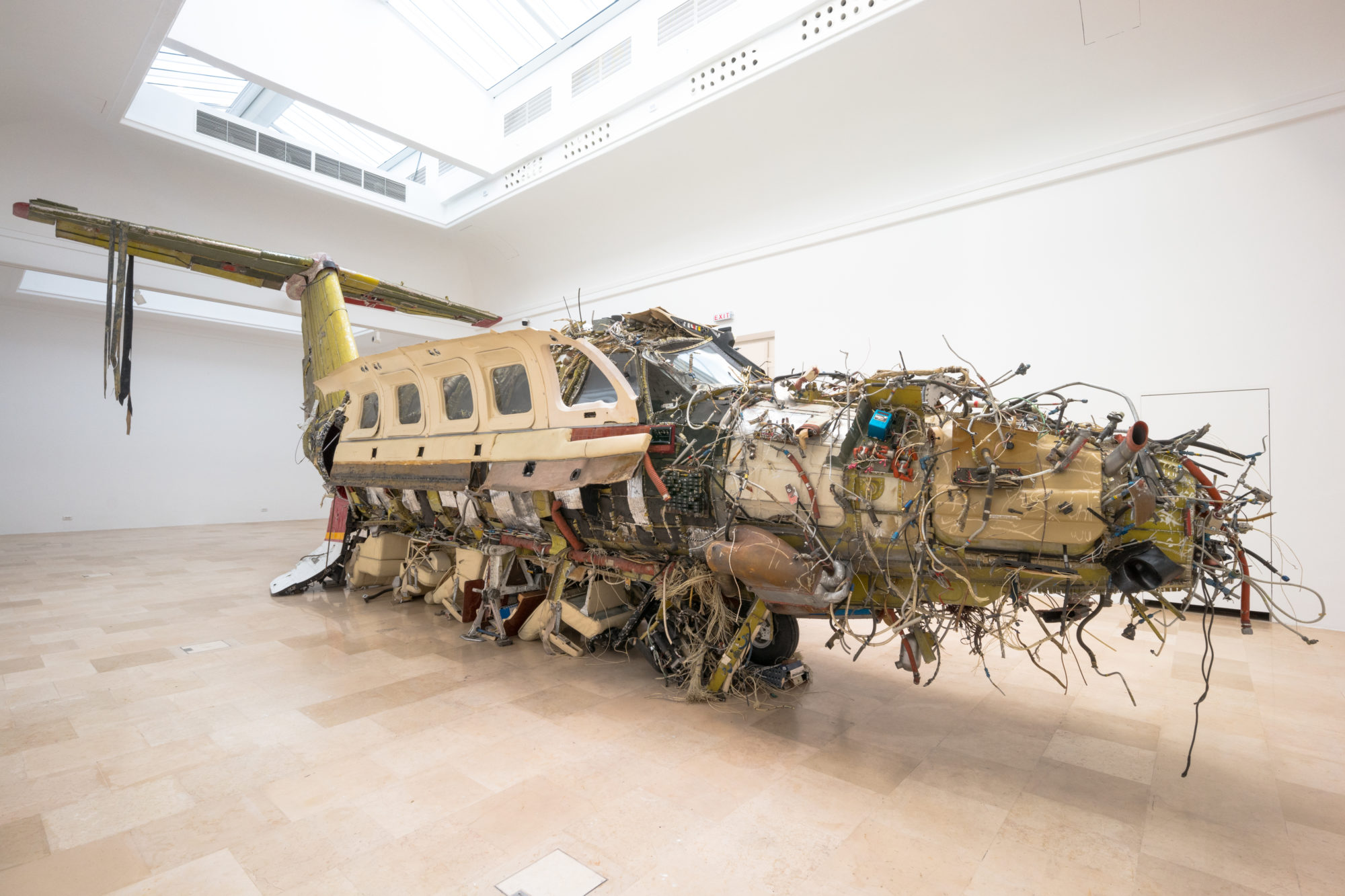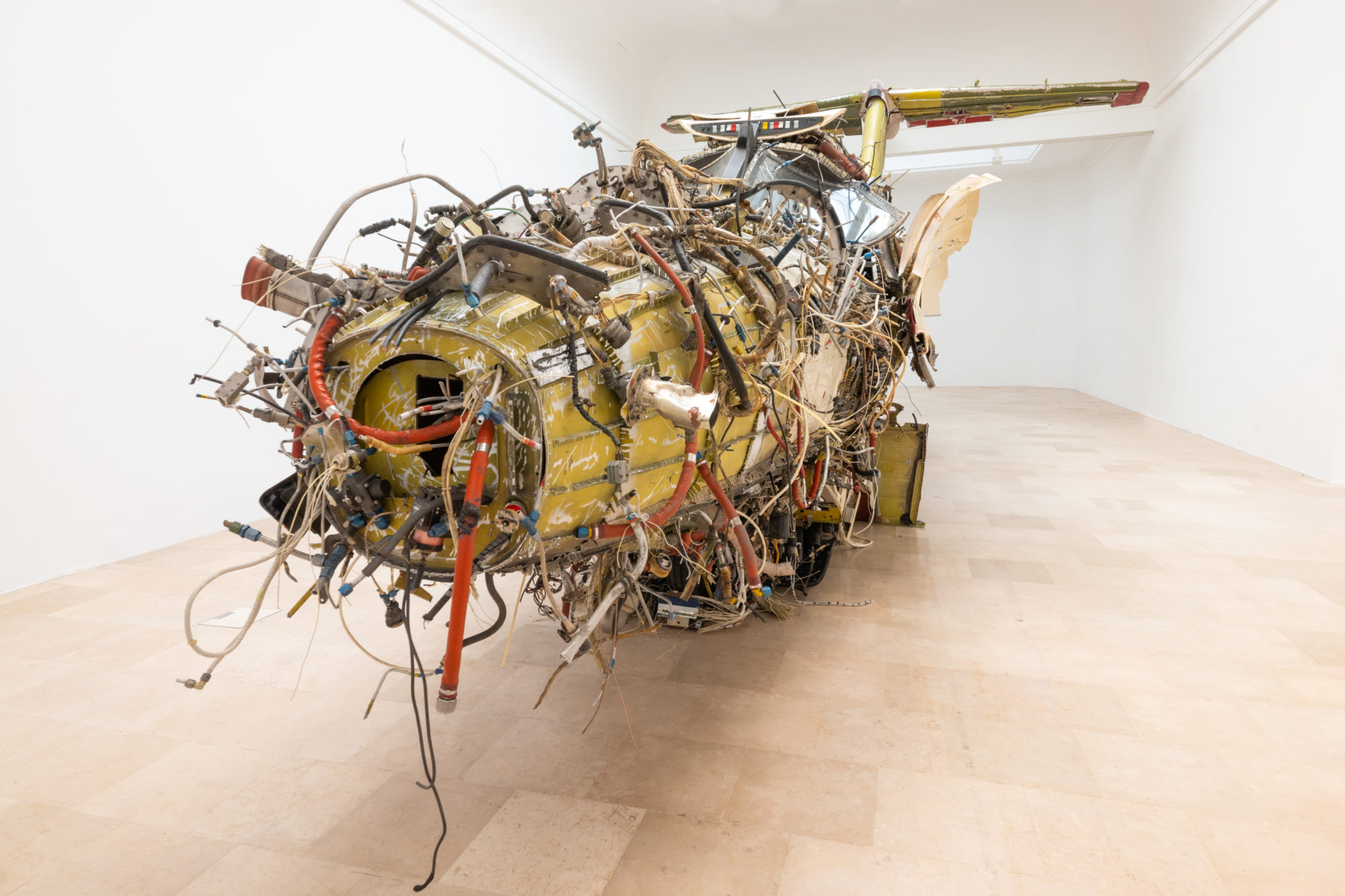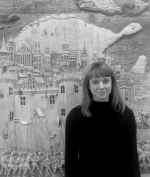Roman Stańczak, Allegories of Flight. Polish Pavilion at the 58th International Art Exhibition—la Biennale di Venezia, 2019

Roman Stańczak. Flight. Polish Pavilion at the 58th International Art Exhibition — la Biennale di Venezia, 2019. Photo courtesy of Weronika Wysocka.
Roman Stańczak’s installation Flight for the Polish Pavilion at the Venice Biennale at once invites and defies final interpretations. The massive sculpture occupying the entire pavilion was created by violently splitting in half a private aircraft, and then sewing it back together inside out. What at first glance could be regarded as a direct reference to the Smoleńsk airplane catastrophe in 2010—dramatically polarizing Polish society, and eventually leading to the victory of the nationalistic, right-wing party Law and Justice—proves to encompass more complex meanings and references. In fact, the work can be perhaps best described as an allegory in the sense offered by Walter Benjamin: an artistic device whose meaning becomes more and more obscure the longer we consider it. Therefore, rather than focusing on a single interpretation, I will highlight some topics and artistic strategies that have characterized Stańczak’s practice since the 1990s and continue to operate in his more recent work.
Born in 1969, Stańczak graduated in the early 1990s from the famous Kowalnia sculpture studio at the Warsaw Academy of Fine Arts where a whole new generation of Polish artists—among them Paweł Althamer, Katarzyna Kozyra and Artur Żmijewski—studied at that time.(“Burdened with a Howl from the Heavens. Roman Stańczak in Conversation with Łukasz Gorczyca and Artur Żmijewski,” in Artur Żmijewski, Trembling Bodies. Conversations with Artists, trans. Søren Gauger, Maciej Głogoczowski (Bytom, Berlin: CSW Kronika, Berliner Künstlerprogramm/ DAAD), 314–315.) Stańczak’s early sculptures consisted of everyday objects such as a kettle, a bathtub or a nightstand, which the artist violently distorted by removing their outer surfaces. In recent years, those early works have attracted significant attention from art critics who have highlighted their political and historical meaning. In fact, the artist’s early sculptures can be seen to express the multi-layered degradation processes experienced in some Polish regions with the advent of capitalism, and the country’s entry into the global market at the turn of the 1990s.(Dorota Michalska, “Rzeźby zdegradowane. Twórczość Romana Stańczaka wobec transformacji ustrojowej po 1989 roku,” Miejsce4 (2018).) The neoliberal reforms in Poland brought about dramatic consequences leading to an exponential increase in income inequality, unemployment rate and the share of population living below the minimum subsistence level. Stańczak’s performances and sculptures, with their depictions of ruined objects, closely correspond to that reality, which for a long time remained outside the scope of interest of Poland’s neoliberal governments and the young generation of artists debuting in the early 1990s. Similarly, in Flight’s case, the act of turning inside-out a small private aircraft used by the global elite, can be seen as a way to address a reality of drastic inequalities and material degradation.(Łukasz Mojsak, Łukasz Ronduda, Two Aircrafts, Curatorial text accompanying the Polish Pavilion: https://labiennale.art.pl/wp-content/uploads/2019/05/FLIGHT-texts-EN-1.pdf, (access online August 2019).)

Roman Stańczak. Flight. Polish Pavilion at the 58th International Art Exhibition — la Biennale di Venezia, 2019. Photo courtesy of Weronika Wysocka.
However, Stańczak’s sculpture at the Venice Biennale can’t be simply regarded in terms of a politically engaged art which exposes the social and material conditions of late capitalism. In fact, from the very start, the artist insisted on the spiritual, almost mystical, dimension of his works. For Stańczak, the act of turning an object inside out was a means of reaching towards the spiritual foundations of reality, of exposing the inner structure of things, of shedding away all that is unnecessary, superficial and illusory.(Roman Stańczak, Life and Work (Rome: Nero Press, 2016), 70–78.) Indeed, his sculptures seem to inhabit a negative space carved out of everyday reality, a space which belongs to the dead rather than to the living. This interpretation is further confirmed by the artist’s Catholic upbringing: several of his works heavily rely on Christian iconography, as in the case of the performance Untitled from 1994. The preserved footage that documents the action shows the artist lying in a bathtub facing its bottom. He then begins to alternately immerse himself and emerge out of water: we can clearly hear him breathing with considerable effort as he tries to inhale as much as air as possible before the next immersion. The performance ends with Stańczak emerging from the bathtub wearing a red perizoma. The work is deeply rooted in Christian iconography through the references to the act of baptism as a rite that bridges the state of living and dying. This is also the case with Flight, which, accordingly to the artist, “is not only about destruction but mostly about hope”. While this statement remains difficult to interpret, one can certainly acknowledge that his practice has a transformative power that is able to reveal a new, unexpected aspect of reality.
The sculpture in the Polish Pavilion also refers to the Smoleńsk airplane catastrophe in Russia in 2010, which killed President Lech Kaczyński and 95 other delegates on board. The disaster has since then become a divisive point of contestation between different political powers in Poland. Despite the catastrophe being deemed an accident in an official report, the country witnessed a wave conspiracy theories which stated that the crash was orchestrated either by Russia or by the liberal government. The political and ideological mobilization of far-right groups in Poland in the wake of the catastrophe is widely regarded as one of the main factors that led to the victory of the nationalist Law and Justice party in 2015. Although this association seems unavoidable nowadays within the Polish context, Stańczak’s sculpture doesn’t offer any kind of immediate, discernible political commentary. This indeterminacy is exactly what makes Flight so compelling: the work—not easily framed by a singular discourse—refers to a number of social, material, political and religious phenomena while not fitting neatly in any of them. Indeed, since the early 1990s, this has been one of Stańczak’s greatest strengths: to be able to convey intense emotions—fear, uneasiness, a sense of despair—to the viewers without referring to a specific discourse or framework.
The decision to commission Stańczak with the project for the Polish Pavilion in 2019 acquires further meaning in the light of the artist’s complex biography. In fact, his artistic practice traces an unusual trajectory within the field of Polish contemporary art. In the early 90s, the artist was widely regarded as one of the most promising young artists to have graduated from the Sculpture Department at the Academy of Fine Arts in Warsaw. His first solo show Sixty-Three Kilos at Warsaw CCA in 1996 attracted almost universal acclaim from critics and curators alike. However, instead of being the start of a brilliant career, it marked its end or rather—from today’s perspective—a hiatus. In fact, shortly after this success Stańczak vanished from the art scene. In a recent interview, he claims that his disappearance in the mid-90s was caused by a range of factors: artistic burnout, alcohol addiction, a wish to live a life outside of art. That situation changed only in 2013, following, on the one hand, the re-discovery of his earlier artistic practice, and on the other hand—with the creation of his new piece Guardian Angel at the Sculpture Park in the Warsaw district of Bródno. As such, Flight marks the final, “victorious” confirmation of Stańczak’s ultimate return to the art world.
The artist’s artistic practice and biography are inextricably, and often dramatically, linked to the last three decades of Poland’s history: the collapse of the Soviet Bloc, the introduction of neoliberal democracy and the recent turn towards radical nationalism. Although his sculptures and performances rarely address political or historical phenomena in a straightforward way, Stańczak’s works are nowadays considered crucial in understanding the artistic and social landscape of contemporary Poland, a country performing a balancing act between faith and disenchantment, modernity and spirituality, late capitalism and pre-modernism. Those contradictions are starkly present in the case of the installation at the Venice Biennale where a luxury jet has been rendered inoperative, its insides—the cockpit, cables and seats—turned inside out. The sculpture’s disfigured materiality implies a catastrophe, or at least a radical change, has taken place whose effects reverberate across different social, historical and spiritual planes.
Articles in this special issue:
[su_menu name=”Venice Biennale”]





